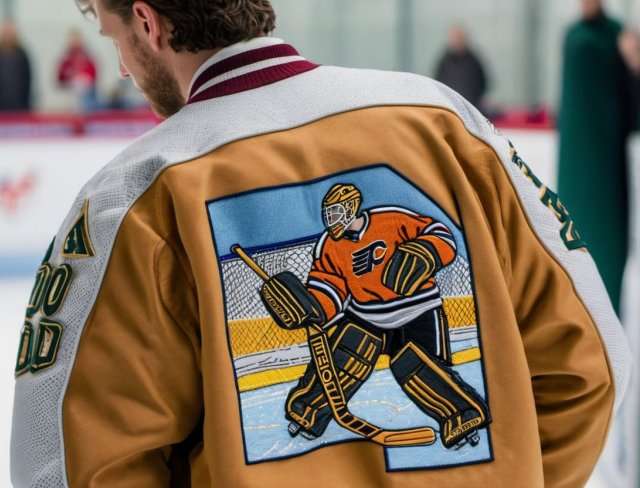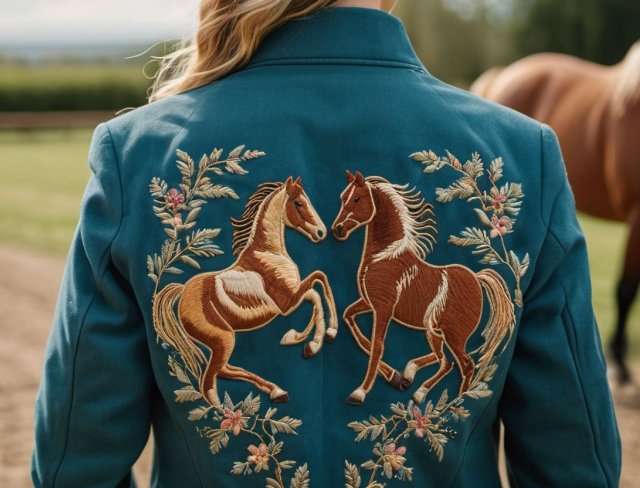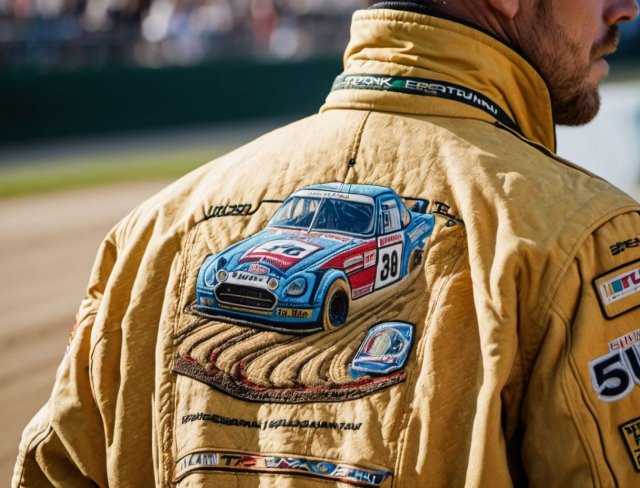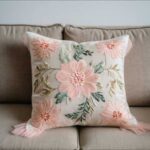Stitched Outerwear
A Beginner's Guide To Jacket Embroidery
Introduction
Embroidery has a rich history dating back centuries, with cultures around the world utilizing this intricate craft to adorn garments, textiles, and ceremonial objects with elaborate designs and symbols. From traditional hand embroidery techniques passed down through generations to modern innovations in machine embroidery technology, the art form continues to evolve, captivating artisans and enthusiasts alike.
Jacket embroidery represents a fusion of traditional craftsmanship and contemporary convenience, allowing individuals to adorn their outerwear with intricate designs and personalized touches. As technology advances, embroidery machines offer increasingly sophisticated capabilities, enabling users to create complex patterns with ease and precision.
In this beginner’s guide, we explore the art and technique of jacket embroidery, uncovering the secrets behind this captivating form of expression. Join us as we journey into the world of stitched outerwear, where creativity knows no bounds and every stitch tells a story.
Understanding Jacket Embroidery
Jacket embroidery opens up a realm of possibilities for personal expression and creativity. Unlike hand embroidery, which relies solely on the skill and dexterity of the artisan, machine embroidery harnesses the power of technology to streamline the process and produce consistent, professional results. By utilizing computerized embroidery machines, enthusiasts and professionals alike can embellish jackets with intricate designs, elaborate motifs, and personalized monograms with remarkable precision and efficiency.
One of the key advantages of jacket embroidery is the ability to replicate complex designs with ease. With the aid of specialized software, users can digitize virtually any image or pattern and transform it into a digital embroidery file. This file serves as a blueprint for the embroidery machine, dictating the placement, sequence, and density of stitches required to recreate the design on fabric. From intricate floral motifs to intricate logos and emblems, the possibilities are limited only by one’s imagination.
Moreover, machine embroidery offers unparalleled speed and efficiency compared to its hand stitched counterpart. While hand embroidery may require hours or even days to complete a single design, machine embroidery can produce the same results in a fraction of the time. This efficiency makes machine embroidery particularly well suited for large scale production, such as creating branded uniforms, corporate apparel, or promotional merchandise.

Furthermore, jacket embroidery allows for greater consistency and uniformity in the finished product. Each stitch is precisely placed according to the digital design, ensuring that every jacket in a batch is identical in appearance. This level of precision is especially important for businesses and organizations seeking to maintain brand integrity and professionalism in their embroidered garments.
In addition to its practical benefits, jacket embroidery offers a canvas for artistic expression and customization. Whether embellishing a jacket with intricate patterns, bold graphics, or subtle monograms, machine embroidery allows individuals to imbue their outerwear with a personal touch that reflects their unique style and personality. From fashion forward embellishments to sentimental keepsakes, embroidered jackets serve as wearable works of art that make a statement wherever they go.
Tips and Techniques
The tips and techniques mentioned below, are just a basic starting point as there are many more options available which aren’t listed here. Different people have discovered methods that work best for them, and during the course of your embroidery, you too will develop your own style of getting the results you want.
1. Choose Quality Materials: When selecting materials for your jacket embroidery project, opt for high quality supplies to ensure professional results. Choose embroidery thread that is specifically designed for use with embroidery machines, such as polyester or rayon thread, as they offer durability, vibrant colors, and a smooth finish. Additionally, invest in quality stabilizers appropriate for your jacket fabric and design complexity, as well as sharp embroidery needles that are compatible with your machine.
2. Select the Right Design: The success of your jacket embroidery project depends on choosing the right design that complements your jacket style and fabric. Consider the size, complexity, and placement of the design to ensure it enhances the overall aesthetic of the jacket. Look for designs with clear outlines and minimal color changes for smoother stitching and a professional finish. Customize the design to reflect your personal taste and style, whether it’s a monogram, logo, or decorative motif.
3. Prepare the Jacket: Proper preparation of the jacket fabric is essential for achieving high quality embroidery results. Start by thoroughly cleaning the jacket to remove any dirt, oil, or debris that could interfere with the stitching process. If necessary, use a lint roller or fabric brush to remove lint or loose threads from the surface of the fabric. Hoop the jacket securely onto the embroidery machine’s hoop, ensuring that the fabric is smooth, taut, and wrinkle free to prevent puckering or distortion during stitching.
4. Digitize the Design: If you’re creating a custom design or modifying an existing one, digitizing the design is a crucial step in the embroidery process. Use specialized embroidery digitizing software to convert your design into a digital embroidery file compatible with your machine. Pay close attention to factors such as stitch density, underlay stitches, and thread colors to ensure optimal results. Test the digitized design on scrap fabric to confirm that it stitches out correctly before embroidering the final jacket.

5. Test Stitching: Before embroidering the design onto the jacket, perform a test stitch on a scrap piece of fabric to check the design’s placement, stitch quality, and thread tension. This allows you to make any necessary adjustments to the design or machine settings before stitching on the actual jacket. Use the same fabric and stabilizer as the jacket to replicate the embroidery conditions accurately. Inspect the test stitch carefully for any issues, such as thread breaks, puckering, or misalignment, and address them before proceeding.
6. Monitor the Embroidery Process: Throughout the embroidery process, it’s essential to monitor the machine closely to ensure smooth and consistent stitching. Keep an eye on the thread tension, needle position, and hoop alignment to prevent problems such as thread breaks, skipped stitches, or misalignment. Adjust the machine settings as needed to maintain optimal stitching quality, and pause the machine if necessary to address any issues that arise during stitching. Trim any jump stitches or loose threads as you go to keep the embroidery area clean and tidy.
7. Experiment with Specialty Techniques: Expand your embroidery repertoire by experimenting with specialty techniques and embellishments to add visual interest and dimension to your jacket designs. Explore techniques such as appliqué, quilting, or 3D embroidery to create texture, depth, and contrast in your designs. Incorporate decorative elements such as beads, sequins, or metallic threads to enhance the overall aesthetic and create eye catching effects. Don’t be afraid to push the boundaries of traditional embroidery and let your creativity shine through in your jacket designs.
8. Finish and Protect the Embroidery: Once the embroidery is complete, take steps to protect and preserve the finished design on your jacket. Remove the jacket from the embroidery hoop and trim any excess stabilizer or thread tails from the back of the embroidery. Gently press the embroidered area with a warm iron to set the stitches and remove any wrinkles.
Consider applying a backing or fusible interfacing to the back of the embroidery to add stability and protect it from wear and tear. Finally, store the jacket in a cool, dry place away from direct sunlight to prevent fading or damage to the embroidery over time. With proper care and maintenance, your embroidered jacket will remain a cherished wardrobe staple for years to come.
Step-by-Step Guide to Jacket Embroidery
1. Prepare Your Workspace: Before you begin embroidering your jacket, ensure that your workspace is clean, organized, and free from clutter. Set up your embroidery machine on a stable surface, such as a sturdy table or workbench, and make sure it is plugged in and ready for use. Gather all the necessary materials for your embroidery project, including the jacket to be embroidered, embroidery thread in your desired colors, appropriate stabilizer, and any additional tools or accessories you may need.

2. Hoop the Jacket: Hooping the jacket properly is essential for achieving accurate and precise embroidery. Begin by selecting the appropriate size hoop for your design and jacket size. Lay the bottom hoop on a flat surface and place the jacket on top, making sure it is smooth and wrinkle free. Place the top hoop over the jacket, sandwiching it between the two hoops, and tighten the screw or clasp to secure the hoops together. If you are using magentic hoops, you will most likely not have any screw or clasp. Ensure that the jacket fabric is taut and evenly stretched within the hoop to prevent puckering or distortion during stitching.
3. Select and Load the Design: Choose the embroidery design you wish to stitch onto your jacket. This can be a premade design from your machine’s built in library or a custom design (which you have digitized yourself or aquired through someone else). Transfer the design file to your embroidery machine using a USB drive or cable connection, following the machine’s instructions for loading designs. Use the machine’s interface to select the desired design, adjust the size and placement as needed, and confirm the settings before proceeding.
4. Thread the Machine: Thread your embroidery machine with the appropriate color thread for your design. Refer to the machine’s manual for guidance on threading, ensuring that the thread is correctly inserted through the thread guides, tension discs, and needle. Use a thread color that complements your jacket fabric and design, and wind the thread onto the bobbin if necessary. Double check the threading to ensure there are no tangles or snags that could disrupt the stitching process.
5. Stabilize the Fabric: Stabilizing the jacket fabric is crucial for preventing stretching, distortion, or puckering during embroidery. Cut a piece of stabilizer slightly larger than the hoop size and place it underneath the jacket fabric, ensuring full coverage of the embroidery area. Use temporary adhesive spray or pins to secure the stabilizer to the back of the fabric, taking care not to distort the fabric or leave residue that could affect the embroidery.
6. Perform Test Stitching: Before embroidering the final design onto your jacket, it’s essential to perform test stitching to ensure proper placement and tension. Select a scrap piece of fabric similar to your jacket material and hoop it with the same stabilizer as your jacket. Stitch out the first few stitches of the design onto the test fabric, checking for any issues such as thread breaks, tension problems, or misalignment. Make any necessary adjustments to the machine settings or design placement before proceeding to embroider the jacket.
7. Embroider the Design: With everything properly set up and tested, it’s time to embroider the design onto your jacket. Place the hooped jacket onto the embroidery machine’s arm, ensuring that it is securely attached and aligned with the needle. Lower the presser foot to hold the fabric in place and begin the embroidery process, following the machine’s instructions for stitching out the design. Monitor the stitching progress closely, pausing if necessary to trim any jump stitches or change thread colors. Allow the machine to complete the embroidery, ensuring smooth and even stitching throughout the design.

8. Finish and Inspect: Once the embroidery is complete, carefully remove the jacket from the hoop and trim any excess stabilizer or thread tails. Gently press the embroidered area with a warm iron to set the stitches and remove any wrinkles. Inspect the finished embroidery for any flaws or irregularities, such as missed stitches or tension issues. Make any necessary touch ups or adjustments as needed, ensuring that the embroidery meets your desired quality standards. Your embroidered jacket is now ready to be worn and enjoyed, showcasing your creativity and craftsmanship for all to admire.
Troubleshooting Trepidations
Embarking on a machine embroidery project can sometimes encounter challenges. Here are eight common problems you may encounter and detailed tips on how to troubleshoot them:
1. Thread Breaks: Thread breaks can be frustrating and are often caused by tension issues, poor thread quality, or needle damage. Begin by checking the tension settings on your machine, ensuring they are correctly adjusted for the type of fabric and thread you’re using. Additionally, using high quality embroidery thread can significantly reduce the likelihood of breaks. Inspect the needle for any signs of damage or dullness and replace it if necessary. By addressing these factors, you can minimize thread breaks and maintain smooth stitching throughout your project.
2. Fabric Puckering: Fabric puckering occurs when the fabric is not properly stabilized during the embroidery process, resulting in unsightly wrinkles or distortions in the finished design. To prevent puckering, ensure that the fabric is securely hooped and stabilized before stitching begins. Use an appropriate stabilizer for the fabric type and design complexity, and avoid stretching or pulling the fabric excessively during hooping. Adjusting the tension settings on your machine and choosing the correct needle size can also help minimize puckering and ensure crisp, clean embroidery.
3. Design Distortion: Misaligned or distorted designs can detract from the overall quality of your embroidery project. To troubleshoot design distortion, start by double checking the hooping and alignment of the fabric on your machine. Ensure that the design is centered and properly scaled to fit the embroidery area, and adjust the hoop tension if necessary.
If the distortion persists, consider digitizing the design again, paying close attention to stitch density and underlay stitches. Experiment with different digitizing settings until you achieve the desired results, and always test stitch on scrap fabric before embroidering the final garment.

4. Thread Nesting: Thread nesting, also known as bird’s nesting, occurs when the thread becomes tangled underneath the fabric, resulting in messy, uneven stitches. To troubleshoot thread nesting, start by checking the bobbin area for any thread buildup or debris.
Clean the bobbin case and surrounding area thoroughly, ensuring that the bobbin is inserted correctly and unwinds smoothly during stitching. Adjusting the tension settings on your machine can also help alleviate thread nesting, as can using a quality bobbin thread that matches the top thread. Finally, ensure that the machine is properly threaded and that the upper thread is securely seated in the tension discs to prevent tangles.
5. Needle Breakage: Needle breakage can occur for several reasons, including using the wrong needle size or type for the fabric, stitching too quickly, or encountering obstacles in the fabric. To prevent needle breakage, start by selecting the appropriate needle size and type for your embroidery project, taking into account the fabric weight and design complexity.
Slow down the stitching speed if necessary, especially when embroidering dense or intricate designs, and avoid running the machine over bulky seams or other obstructions. Regularly inspect the needle for signs of damage or wear and replace it as needed to maintain smooth, consistent stitching.
6. Uneven Stitching: Uneven stitching can result from a variety of factors, including tension issues, hooping errors, or machine malfunctions. To troubleshoot uneven stitching, start by checking the tension settings on your machine and adjusting them as needed to achieve balanced stitches.
Ensure that the fabric is hooped securely and that the hoop is properly aligned with the machine’s embroidery arm. If uneven stitching persists, inspect the machine for any mechanical issues, such as bent or misaligned needle bars, and address them accordingly. Additionally, experiment with different stabilizers and hooping techniques to achieve more consistent results across different fabric types and designs.
7. Thread Fraying: Thread fraying can occur when the thread is subjected to excessive tension or abrasion during stitching, resulting in frayed or broken threads and compromised embroidery quality. To prevent thread fraying, start by selecting a high quality embroidery thread that is specifically designed for machine use and is less prone to fraying.
Ensure that the thread is properly threaded through the machine’s tension discs and that the tension settings are adjusted to minimize stress on the thread. Avoid using thread that is old or brittle, as it is more likely to fray during stitching. Finally, check the needle for any burrs or rough spots that could cause friction and contribute to thread fraying, and replace it if necessary.

8. Color Bleeding: Color bleeding can occur when the dyes in the fabric or thread migrate during the embroidery process, resulting in blurred or distorted colors in the finished design. To prevent color bleeding, start by prewashing the fabric to remove any excess dyes or sizing agents that could cause bleeding during stitching.
Use high quality embroidery thread that is colorfast and resistant to bleeding, and test stitch on a scrap piece of fabric before embroidering the final garment. If color bleeding does occur, try using a color catcher or dye fixative to set the colors and prevent further bleeding. Additionally, consider using a water soluble stabilizer to minimize contact between the thread and fabric, reducing the risk of color migration.
By addressing these common troubleshooting issues and implementing the recommended tips and techniques, you can overcome challenges and achieve professional quality results in your machine embroidery projects. With patience, practice, and attention to detail, you’ll be able to create stunning embroidered garments that showcase your creativity and craftsmanship.
Conclusion
Machine embroidery offers a versatile and efficient method for embellishing jackets with intricate designs and patterns. By following expert tips, selecting quality materials, and troubleshooting common challenges, you can achieve professional results and create unique statement pieces that reflect your individual style. So, fire up your embroidery machine, select your favorite design, and let your creativity soar as you embark on the exciting journey of jacket embroidery!
Additionally, as you delve deeper into the world of jacket embroidery, remember that practice makes perfect. Don’t be discouraged by initial setbacks or challenges; instead, use them as opportunities to learn and improve your skills. Experiment with different techniques, explore new design ideas, and allow yourself the freedom to express your creativity fully.
Whether you’re embroidering jackets for personal use, as gifts for loved ones, or as part of a business venture, the possibilities are endless. With dedication, patience, and a passion for the craft, you’ll soon become a master of jacket embroidery, delighting yourself and others with your stunning creations.
Now that you have read through this article, feel free to SHOP for products we have created. If you are looking for something special which isn’t in our store, feel free to contact us.














